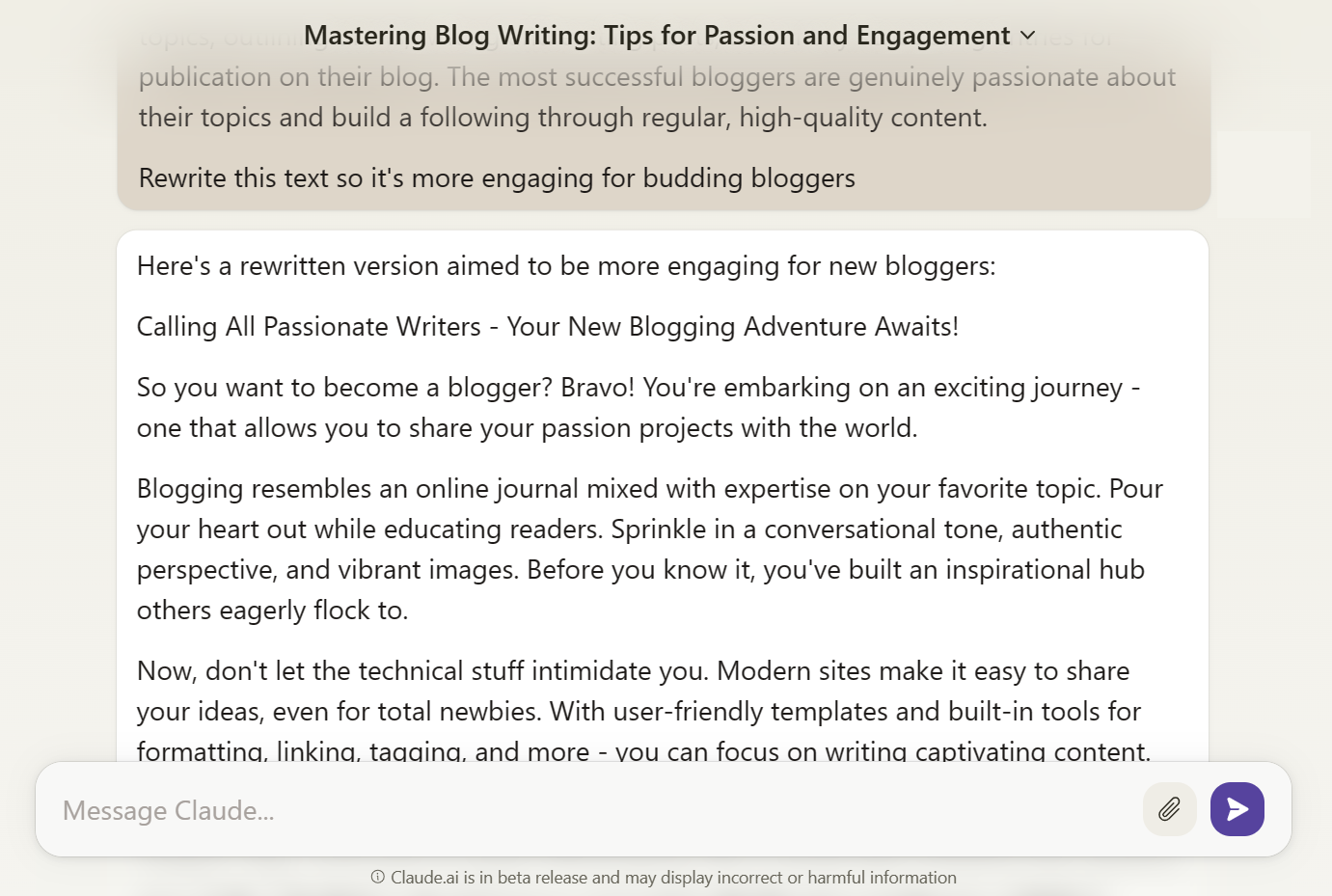Using AI to Edit Blogs Effectively: An Editor’s Guide

As we enter 2024, the hype surrounding AI tools is anything but relenting. While artificial intelligence (AI) is opening up new possibilities in virtually all industries, it’s also ushering in uncertainty and, for some, trepidation. You might be wondering what AI’s role is in the editing sphere and what its repercussions are on your daily work and career outlook—particularly if you’re using AI to edit blogs.
Welcome to our expert guide to AI-powered blog editing. We’ll address your concerns directly, walking you through AI’s benefits and specific use cases for editing blog content. We’ll explore a selection of the best AI tools you should consider adding to your editing arsenal. Most importantly, we’ll help you strike the perfect balance between streamlining your workflow with AI and maintaining the human touch that defines quality content.
Table of Contents
Should You Get on the AI Train?
The short answer is yes. AI isn’t a fly-by-night tech fad—it’s a train accelerating faster than many of us can keep pace with. The already multibillion-dollar AI market size is set to triple by 2030. To put a number to it, we’re looking at $738.80 billion.
The reality is that people are already using AI across the content creation lifecycle, from ideation to distribution. A recent widescale survey found that 65% of bloggers use AI for various tasks. In the constantly changing and highly competitive digital content landscape, we, as editors, simply can’t afford to let this train pass us by.
More and more editors are finding that AI can be a powerful ally. When used effectively, AI editing tools excel at catching grammar and spelling errors, enhancing readability scores, and picking up problems with tone or structure. This allows human editors to focus less on mechanical tasks and more on big-picture content improvements. AI can handle the tedious gruntwork while boosting editors’ overall efficiency and productivity.
While some may worry about the reliability of AI, the key is to view it as a supplement to your expertise, not a substitute. Editors need to understand the tools they use and their limitations. Ultimately, using AI effectively means using AI responsibly.
How Can You Use AI to Edit Blogs?
Now that we’ve hopefully got you on board, you’ll want to know the details of what AI can actually do. Here are just some of the ways you can enhance blog editing with AI:
Background Research
As an editor, you must fully understand the subject matter you’re reviewing. AI tools can gather extensive amounts of relevant information, summarise it, and simplify complex jargon and technical concepts. In minutes, you can be well-versed on almost any blog topic.
Proofreading
AI-powered writing assistants are invaluable for ensuring your blog is free of grammatical, spelling, and punctuation errors. They also detect repetition, redundancies, overused words, and cliches. While you’re probably immediately able to spot a concord error or incorrect preposition, sometimes the finer details, like an extra space, can fly under the radar.
Content Analysis
AI content analysis tools can evaluate the overall quality and structure of the blog post. They can provide insights into sentence length, readability, engagement, sentiment, and clarity.
Content Enrichment
If the blog you’re editing is one-dimensional, an argument needs better support, or a description lacks detail, various AI writing tools can help you find solutions. They might give multimedia suggestions, find supporting statistics or quotes, turn long paragraphs into easy-to-read bulleted lists, and even source real-life examples and relevant case studies.
Plagiarism Detection
Submitting plagiarised content can devastate a blog’s reputation and harm SEO rankings. AI software can scan posts to determine if any passages match content published elsewhere online. This allows you to paraphrase any concerning sections or properly cite sources to avoid negative repercussions.
Metadata Generation
Creating quality metadata is essential for blogs to get discovered. Rather than manually writing alt tags, meta descriptions, and meta titles for every post, AI metadata generators can instantly supply optimised suggestions. This metadata gives blogs a better chance of ranking in search engines and attracting clicks.
Content Optimisation
Having great metadata is only one aspect of optimised content. SEO can be a complicated and time-consuming task, but it’s essential if you want your blog to gain traction. Some AI tools analyse top-performing competing pages and provide recommendations for keyword usage, content length, and other on-page SEO factors that can help you outrank them.
AI software also audits content that’s already been published and provides extensive recommendations on where and how to improve, helping you tick all the boxes on your online editing checklist.
How Not to Use AI to Edit Blogs
A guide on using AI to edit blogs wouldn’t be complete without some sort of disclaimer or advice on what to avoid. Keep the following in mind as you set off on your AI blog editing journey:
- Never rely solely on AI tools to edit blog posts. You should still actively implement all editing best practices and decide which changes to make and which suggestions to ignore.
- In a similar vein, don’t assume that AI is always correct and accurate. At this stage of AI development, suggestions often presented as facts could likely be wrong.
- Don’t expect AI, especially spellchecking tools, to pick up every mistake. Errors frequently slip through the cracks.
- Don’t neglect to learn the tool’s nuances. You must be aware of its capabilities and limitations to avoid oversights and quality issues.
- AI is not a miracle worker. While AI can do much, we can’t expect it to transform low-quality writing into something extraordinary. It works best with drafts that are relatively decent to begin with.
What Are the Best AI Tools to Edit Blogs?
ChatGPT and perhaps Bard and Bing may immediately come to mind when discussing AI, especially for those who use AI to write or brainstorm blog outlines. However, AI extends far beyond these tools, with capabilities that are also far more wide-reaching. Unfortunately, blindly relying on one general chatbot like ChatGPT won’t cut it.
Instead, think of AI as a toolkit. A hammer alone won’t get you very far in a woodworking project. You need to find the right assortment of AI tools to fulfil the many different tasks involved in the editing process.
To help get you started, here’s a rundown on some of the best AI editing tools for blogs:
Grammarly
The OG grammar checker, Grammarly, is now powered by AI for more accurate grammar, punctuation, clarity, and flow suggestions. It’s free for basic use and affordable for premium features like plagiarism detection. Grammarly integrates directly into your word processor for real-time feedback as you type.
While Grammarly is robust, it can sometimes miss the context and suggest changes that don’t fit the intended meaning. Carefully check that you agree with its suggestions. You’ll probably find yourself clicking “dismiss” for several of its recommended changes.

ProWritingAid
Going far beyond the basics, ProWritingAid offers in-depth writing reports, which provide editors with a list of overused words, readability scores, and sentence-length variations. It’s particularly useful for long-form content.
However, ProWritingAid can be slightly intimidating due to the sheer amount of information and suggestions it provides. And, like Grammarly, it doesn’t always give accurate tips, so human discernment is still a must.

Hemingway Editor
Hemingway Editor is an AI-powered editor that analyses your text, highlights hard-to-read sentences, and helps simplify content for broader audiences. It gives you a readability grade based on the Flesch-Kincaid readability test. Plus, its colour-coded feedback is a unique feature facilitating faster editing times.
While it’s great for making blogs bold, clear, and concise, Hemingway Editor can be somewhat rigid in its suggestions. So, make sure the writer’s unique voice doesn’t get obscured.

ChatGPT
ChatGPT is a natural language processing model that’s especially helpful for researching topics and brainstorming ideas. This AI chatbot can also rewrite and restructure content to improve flow, transitions, word choice, and engagement.
However, it may not always grasp the nuances of human emotion or the specific tone intended for a blog. We strongly advise editors to review and refine content after using ChatGPT.

Claude
Compared to ChatGPT, Claude has more reliable language capabilities. We find it’s better at ensuring consistent tone and style and producing more natural-sounding dialogue or text.
The main drawback is that Claude can reach capacity quickly, giving you an error message that it can’t generate content or an answer immediately.

Jasper
Jasper offers an extremely popular AI blog writing assistant that provides real-time grammar, style, and word choice edits as you write in Google Docs.
The instant feedback helps catch issues early, and its intuitive interface has a much gentler learning curve than similar software. It’s also very helpful in summarising blog posts into engaging snippets for social media.
Jasper is generally more focused on copywriting as opposed to copyediting tasks, but it does come in handy if you need to rewrite or add considerable amounts of blog content.

Surfer SEO
Optimising content with AI has never been more efficient. Surfer SEO provides advanced recommendations to optimise blog posts and web content for search engines. It analyses aspects like word count, keyword choice and density, number of headings and paragraphs, internal links and backlinks, and page speed.
While its SEO advice is comprehensive, Surfer SEO lacks broader writing or editing functionality. It also comes with a heftier subscription fee than competitors like Frase.

Copyscape
Copyscape is essential for ensuring content originality. It checks for plagiarism and can help protect your blog from copyright infringement issues. While it’s one of the best plagiarism checkers, it doesn’t offer broader editing features, so you’ll need to use it with other editing tools.

If used correctly, each of these AI tools can contribute to your editing and writing process. The best choice often depends on the specific needs of the blog and the editor’s preferences. Fortunately, most AI software comes with a free basic plan or a free trial, so be open to trying various AI editing tools to find the ones that resonate best with you.
Will AI Replace Editors?
A common concern is that AI will become so advanced that human editors will no longer be needed. However, with the limitations we’ve discussed in mind, it’s very unlikely that AI will replace editors anytime soon. These tools may be “intelligent” but often lack common sense. AI simply can’t replicate the critical thinking, empathy, creativity, and contextual understanding that human editors bring to the table.
Furthermore, AI cannot create content from scratch, fact-check, or make subjective decisions about content. AI is also not infallible and can make errors, especially if it isn’t trained on high-quality data.
Even the most advanced AI chatbots remain brittle. They work well within their training domain but quickly fall short when given unfamiliar inputs.
If that’s not enough to allay your fears, just remember that almost three times as many bloggers work with editors today than they did 10 years ago. And this figure is only set to rise. With the surge of businesses and individuals turning to partially or fully AI-generated content, there’s a significantly greater demand for skilled editors to quality-check, fact-check, and “humanise” content composed by AI.
When Man Meets Machine: The AI Advantage
When used properly by knowledgeable editors, AI enables us to produce higher-quality blog content at scale. We can allocate more time towards other types of editing than just language, including strategy, creativity, and compellingly conveying ideas to move audiences—the very things that make human editors irreplaceable.
Harnessing AI capabilities to their full potential involves continual self-education and openness to change. The AI landscape will continue shifting and progressing, with new tools and functionalities emerging steadily. But when man learns to collaborate rather than compete with machines, the future of editing digital content has never looked brighter.

Blue Leaf Team
The Blue Leaf Editing team has over 10 years of combined editing, publishing, and book industry experience. We’re passionate about content and storytelling, and sharing our knowledge with others.
info@blueleafediting.com